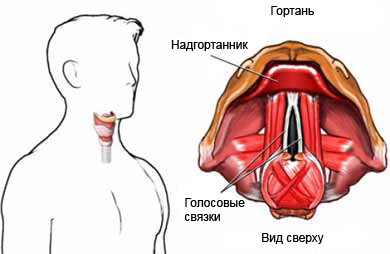Cancer of the larynx
Description of laryngeal cancer
Laryngeal cancer is a disease, in which cancer cells grow in the larynx. Throat – the tubular body inside the neck, which is located between the throat and the windpipe. The main function the larynx is to produce sound for speech.
Cancer occurs, when the cells of the organism (in this case the cells laryngeal) divide without control and order. If cells keep dividing uncontrollably, when the body does not need new cells, excrescent (weight) of cloth, called a growth or tumor. The term cancer refers to malignant tumors, that can invade nearby tissues and spread to other parts of the body. Benign tumors do not spread to other organs.

Causes of laryngeal cancer
The cause of laryngeal cancer is unknown.
Risk factors for laryngeal cancer
Factors, which increase the risk of cancer of the larynx:
- Smoking (the most common risk factor);
- Excessive alcohol consumption;
- Age: 55 and older;
- Paul: male;
- Exposure to certain air pollutants, such as wood dust, chemical substances, and asbestos;
- Gastroesophageal reflux disease (GERD) – Acid from the stomach into the esophagus and throat, where it can come in contact with the tissues of the larynx;
- Weakened immune system;
- Laryngeal dysplasia (a precancerous condition).
The symptoms of laryngeal cancer
Symptoms may include:
- Persistent cough, hoarseness or sore throat;
- Abnormal lump in the throat or neck;
- Difficulty swallowing;
- Pain when swallowing;
- Frequent choking while eating;
- Labored breathing;
- Noisy breathing;
- Persistent ear pain or a feeling of stuffiness in the ears;
- Sudden significant weight loss;
- Persistent bad breath.
These symptoms, in addition to laryngeal cancer, They may be caused by other, less serious diseases. If you experience these symptoms, consult a doctor.
Diagnosis of cancer of the larynx
The doctor will ask about your symptoms and medical history, and perform a physical examination. Tests may include:
- Laryngoscopy – throat studied using a thin tube, which is inserted into it through the mouth;
- Biopsy – removal of a sample of tissue of the larynx to check for cancer cells;
- Chest X-ray – test, which uses X-rays, to make pictures of the larynx and nearby organs;
- CT scan (CT) – type of X-ray, which uses computer, to make pictures of the inside of the larynx;
- Magnetic resonance imaging (MRT) – test, which uses magnetic waves, to make pictures of the inside of the larynx.
Treatment of cancer of the larynx
Following the discovery of cancer of the larynx survey is conducted, allowing to determine the extent and scope of cancer. The treatment method depends on the stage of cancer. At an early stage of cancer of the larynx or used surgery, or radiotherapy. In the later stages of the disease the most common treatments are radiation therapy (together with chemotherapy) or surgery followed by radiation therapy.
Methods of treatment include:
Surgery for cancer of the larynx
The surgery is performed to remove a cancerous tumor, and surrounding tissues, perhaps, neighboring lymph nodes. Options for operations in cancer of the larynx:
- Total laringektomija – It involves the removal of the larynx, including vocal chords;
- Partial laryngectomy – the surgeon removes the cancerous tissue, leaving as much of the vocal cords;
- Tracheotomy – to help with breathing, in the neck below the throat opening is performed. It can be a temporary (in the recovery period after surgery) or permanent, in the case of large tumors laryngeal, which is problematic to remove;
- Neck dissection – It involves removing lymph nodes, and part of the neck muscles, to determine the extent of cancer spread.
Radiation therapy (or radiotherapy)
Radiation therapy – Use of radiation, allowing to kill cancer cells and shrink tumors. It can be applied in the form of external radiation therapy, when the beam is directed at the tumor from a source outside the body.
Chemotherapy for cancer of the larynx
Chemotherapy – the use of drugs to kill cancer cells. Preparations for the chemotherapy may be given in various forms: tablets, injection, the introduction of a catheter. The drugs enter the bloodstream and spread throughout the body, killing mostly cancer, and also some healthy cells. Chemotherapy may be used to reduce the size of very large tumors.
Prevention of cancer of the larynx
Since non laryngeal cancer is extremely rare, the best way to prevent this type of cancer – Do not smoke. Other measures, that could reduce the risk of cancer of the larynx:
- Avoid excessive use of alcohol;
- Protect yourself from toxic substances, which can be linked to cancer of the larynx.
